What is Tzatziki Sauce? (Beyond the White Gyro Sauce)
You know that question about your desert island food? Tzatziki would be mine.
At its core, tzatziki is a yogurt-based dip made with strained yogurt (also known as Greek yogurt), cucumber, garlic, lemon juice, and herbs (typically dill or mint).
Referred to by many names, such as Greek Tzatziki sauce, Tzatziki Sauce, and Cucumber Yogurt Sauce, it can be served as a dip, a sauce, or even as a dressing.
It pairs well with just about anything, from meat to gyros, to Turkish kebabs, to grilled or roasted vegetables.
While many people in the U.S. know it as the white sauce that comes with a gyro, that version is often heavier, sometimes made with mayonnaise or sour cream, and doesn’t always include cucumber.
My homemade tzatziki sauce recipe is different here. It’s the real thing. The kind of tzatziki you’ll find on tables in homes across Turkiye, Greece, and beyond.
Essential Ingredients for Authentic Tzatziki (And Why They Matter)
The good news is that this easy tzatziki recipe requires only a few simple ingredients and comes together in minutes. You’ll find the full list in the recipe card below, but here are a few helpful tips to keep in mind when shopping:
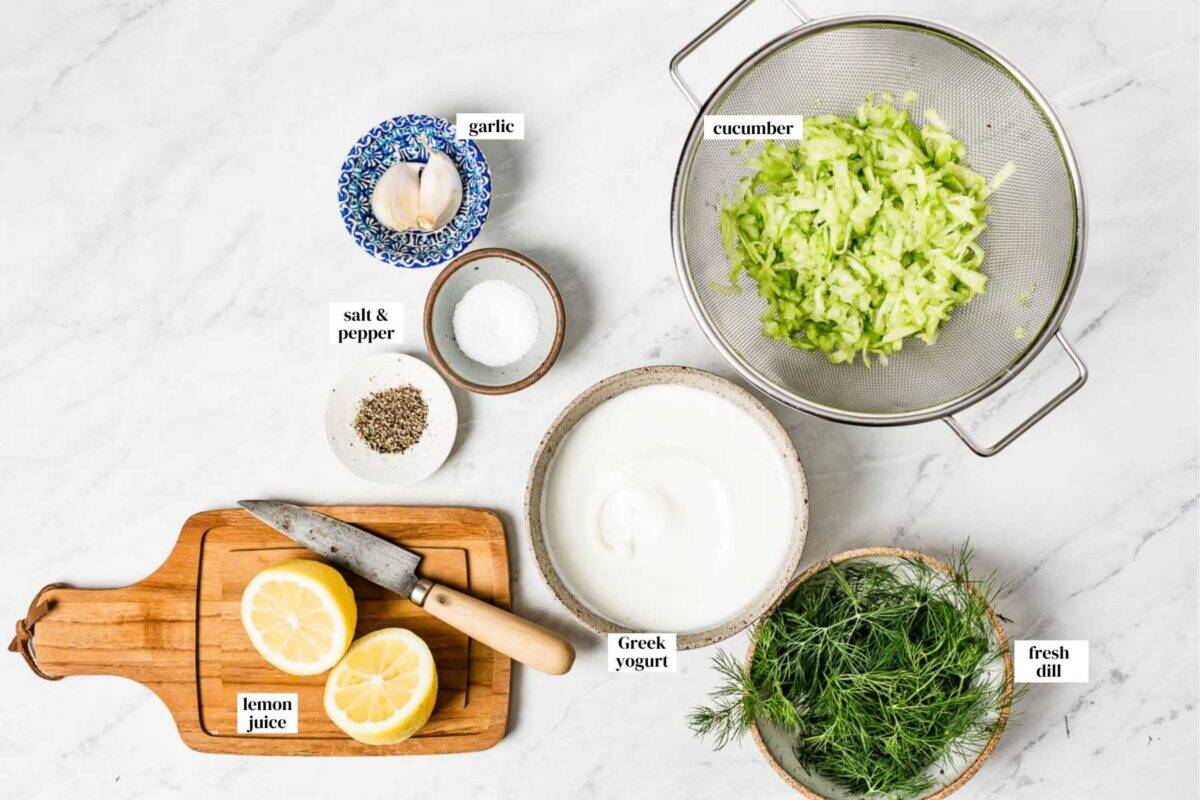
Full-fat Greek Yogurt (also known as Strained Yogurt): I think the best yogurt for tzatziki is a whole-milk, plain Greek yogurt. It yields a rich and creamy tzatziki dip, a main characteristic of this Mediterranean sauce. If your container has any liquid sitting on top, be sure to strain that out before using.
You can also use plain, unsweetened yogurt or even low-fat or fat-free yogurt, but the texture will be a bit looser compared to Greek yogurt.
Fresh Cucumber: Either Persian or English cucumbers work well. I like to peel them first, as some cucumber skin can be bitter. Still, it is a personal preference.
I grate them using the large holes on a box grater and then drain them in a mesh sieve. It might seem like an extra step, but thoroughly draining the grated cucumber helps eliminate excess liquid, giving you the thick, creamy consistency that this cucumber tzatziki sauce is known for.
Fresh Garlic Cloves: The traditional version of this Mediterranean yogurt sauce calls for fresh, finely minced garlic. I usually add two cloves per 1 ½ cups of yogurt, but feel free to adjust the amount based on your preferences.
If you prefer a milder flavor, garlic powder is a fine substitute. Since it’s more concentrated, I recommend using about 1 teaspoon per 1 ½ cups of yogurt.
Fresh Herbs: I like using fresh dill, but fresh mint is another classic option. In Turkiye, it’s also common to use dried dill or mint if fresh isn’t available. That said, I think fresh herbs bring a brighter, more vibrant taste.
Fresh Lemon Juice: Just a squeeze is enough to brighten the flavors and balance the richness of the yogurt.
Kosher Salt and Black Pepper: You won’t need anything beyond basic seasoning here. Start with the amounts listed in the recipe and adjust to taste.
Extra Virgin Olive Oil (Optional): You won’t see olive oil listed in my recipe because my mom never used it. I find that thick, whole-milk yogurt gives the sauce all the richness it needs. However, if you’d like to add it, a tablespoon of olive oil per 1 ½ cups of yogurt is a good starting point.
How to Make Easy Homemade Tzatziki: A Step-by-Step Guide
Making a delicious tzatziki with yogurt, shredded cucumber, and lemon juice doesn’t require any special cooking techniques, so anyone can do it.
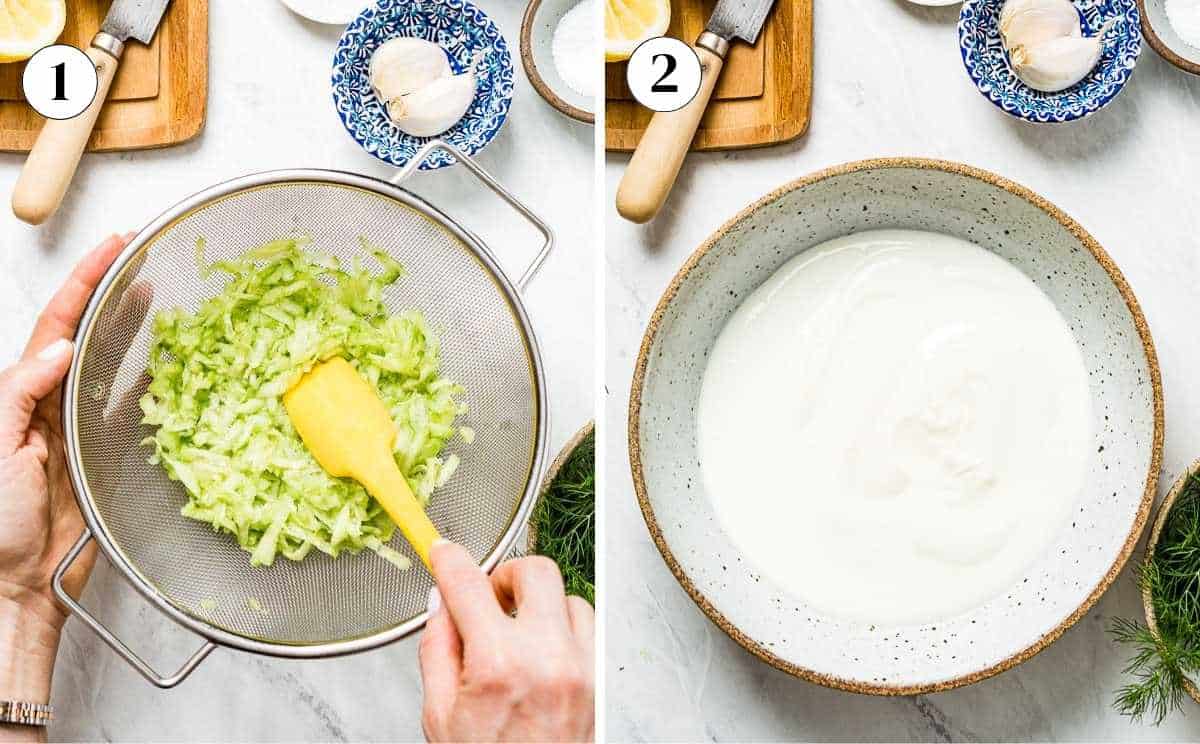
Step 1 – Grate and drain the cucumber: Using the large holes of a box grater, grate the peeled cucumber and transfer it to a fine-mesh strainer. Press down with a spatula to release the excess moisture. I usually let it sit for a few minutes to help the juices drain completely.
Once drained, you should have about 1 cup of grated cucumber.
Alternatively, you can wrap the shredded cucumber in a clean tea towel and squeeze it by hand to remove as much liquid as possible.
Step 2 – Whisk the yogurt base: In a medium bowl, combine the Greek yogurt, freshly squeezed lemon juice, minced garlic, salt, and black pepper.
Whisk until smooth and creamy. This is also a good time to give it a quick taste and adjust the seasoning if needed.

Step 3 – Add cucumber and herbs: Fold in the drained cucumber and fresh dill or mint. Mix until everything is evenly combined.
Step 4 – Cover and chill:
You can serve it right away, but if you have the time, cover and let it rest in the fridge for at least 30 minutes. This allows the flavors to meld and deepen.

Easy Tzatziki Sauce Recipe
Equipment
Ingredients
- 1 English Cucumber, peeled (or 2 Persian cucumbers)
- 1 ½ cups Whole Milk Greek Yogurt, unsweetened and unflavored
- 2 tablespoons lemon juice, freshly squeezed
- 2 cloves fresh garlic, peeled and minced finely
- 1 teaspoon Kosher salt
- ¼ teaspoon black pepper
- ⅓ cup fresh dill, or fresh mint
Instructions
- Using the large holes of a box grater, grate the cucumber. Transfer it into a fine-mesh strainer and strain all of its juices, pressing it with a rubber spatula. Set aside.
- In a medium-size mixing bowl, whisk together yogurt, lemon juice, minced garlic, salt and pepper.
- Using a spatula, fold in the cucumber and dill. Transfer to a bowl.
- If you have time, cover with plastic, and let it sit in the fridge for a few hours before serving.
Video
Notes
- Yields: This recipe makes about 1 ¼ to 1 ½ cups of tzatziki sauce which is ideal for 4 servings as a condiment. The nutritional values below are per serving.
- Make Ahead: Make the recipe as written up to 2 days before serving. Place it in an airtight container and store it in the fridge. Be sure to give it a good stir before serving.
- Storage: This sauce will stay fresh for about 3-4 days. Simply place leftovers in an airtight container and keep them in the fridge. If you notice any liquid separation, just give your Tzatziki a good stir before serving.
- A word on olive oil: My recipe relies on rich yogurt for creaminess and does not require adding any olive oil, unlike some other tzatziki recipes. However, for extra depth, drizzle 1 tbsp extra virgin olive oil on top before serving.
Nutrition
Nutrition information is automatically calculated, so should only be used as an approximation.
Expert Tips from a Lifelong Tzatziki Maker
This recipe is pretty straightforward, but there are a few things I want to point out so you can end up with the best tzatziki on your first try:
- Don’t skip draining the shredded cucumber: This is the single most important step when it comes to achieving that creamy texture tzatziki is known for. Yes, it’s an extra step, but it makes all the difference.
- DIY Greek Yogurt: If you don’t have Greek yogurt, you can strain plain yogurt at home. Just place a fine-mesh sieve over a bowl and line it with cheesecloth (a paper towel will also work in a pinch). Add the yogurt, cover it, and let it sit in the fridge for a few hours. The longer it sits, the thicker it becomes.
Since plain yogurt has more liquid, I recommend using about half a cup more than the recipe calls for to account for the liquid that will drain. - Avoid overmixing: Once you have folded in the cucumber and herbs, mix only until the ingredients are just combined. Overmixing can cause the cucumber to release more liquid, which may water down the sauce.
- Do not skip the chilling: To me, the secret to the best tzatziki sauce is letting it rest in the fridge. This time allows the flavors (especially the garlic and fresh herbs) to develop and deepen. Even just 30 minutes makes a difference, but planning for an hour or two can yield even better results.
How To Make Ahead and Store?
Make Ahead: You can make this Greek tzatziki sauce recipe a day or two ahead. Just be sure to transfer it to an airtight container and store it in the fridge.
Storage: Leftovers will keep for up to 3 days in the refrigerator. Give it a good stir before serving, and if any liquid has collected on top, simply pour it off or drain it before mixing.
Delicious Ways to Serve Tzatziki Sauce in Your Daily Cooking

I may or may not have been caught eating this Mediterranean classic with a spoon. All jokes aside, tzatziki is a staple for a reason. It pairs beautifully with just about any meat or vegetable dish that could use a cooling, creamy contrast. Here are a few of my favorite ways to use it:
Kabobs and Gyros: Simply drizzle it right on top! If you want to try something different, try drizzling this sauce over my Karniyarik recipe (aka Turkish Stuffed Eggplant), Greek Yogurt Chicken, Shish Taouk, or Baked Chicken Kabobs, Chicken Shawarma, or serve it with Turkish Kofte.
Sauce for Burgers and Sandwiches: I love using it as a spread for Greek Lamb Burgers (pictured above) or my Chicken Pita Wraps. It adds a creamy contrast and brings everything together.
Vegetables and Vegetable Dishes: A dollop of tzatziki can turn simple roasted eggplant into a delicious appetizer. It’s also a great match for baked zucchini fritters, crispy falafel, or just about any veggie-forward dish you’d serve at a gathering.
With Salads: Tzatziki isn’t just a dip; it makes a fantastic, creamy addition to various salads. I particularly love a dollop alongside or even mixed into my easy Greek salad for an extra layer of freshness.
Grain Bowls: Drizzle it over shawarma chicken bowls (pictured above) or make it part of a DIY Cava bowl. It adds creaminess and brightens the rest of the toppings.
Part of a Meze Platter: Serve it in a bowl as a dip on a large platter along with cheese and crackers, olives, hummus, muhammara, pita bread (or pita chips), and fresh raw vegetables.
Tzatziki Sauce Variations & Substitutions:
- Dairy-Free/Vegan Options: To make this vegan or dairy-free, use a neutral-flavored plant-based yogurt. I prefer unflavored cashew yogurt, but coconut or almond milk yogurt can also work. Just make sure it’s unsweetened and as thick as possible for the best consistency.
- Herb Variations: You can easily make this creamy tzatziki sauce your own by switching up the herbs. Fresh dill and mint are classic options, but parsley or chives are also great alternatives. No fresh herbs on hand? You can leave them out and still have a delicious dip.
- Making it Thinner (like Turkish Cacık): If you have ever been to Turkiye, you’ve probably had cacik, a thinner version of tzatziki. To achieve that texture, simply use plain yogurt instead of Greek yogurt, or stir in about ½ cup of cold water (or more, depending on your preference) until you reach the desired consistency.
FAQs:
The phonetic spelling is /tsaˈtsiːki/. The word for this Greek yogurt cucumber sauce is spelled T-Z-A-T-Z-I-K-I. It is a loanword from Modern Greek, which actually comes from the Turkish word cacık, of unknown origin.
So, how do you say Tzatziki? The correct way to pronounce Tzatziki is “tsah-see-key.” Think of the tsah part as how you say “pizza,” without the first two letters.
Technically, you can freeze yogurt, but after thawing, it loses its creamy consistency. This is generally true for most savory yogurt-based dressings or sauces. Therefore, I wouldn’t recommend freezing Tzatziki sauce.
Yes, you can use any plain yogurt you like. However, I recommend sticking to Greek Yogurt as it is thicker than other yogurt types. The higher the fat content, the more delicious and creamy it would be, but non-fat or low-fat plain yogurt would still do the job.
The correct answer is yes. Some people even go as far as straining yogurt and cucumber in a colander lined with cheesecloth overnight in the fridge. I guess it is because they prefer a thicker consistency. However, in my opinion, the thickness of Tzatziki is a personal preference. If you like yours runny then no need to strain the juices and vice versa.
It is a personal preference. I prefer to peel mine as some cucumber skin can be bitter.
I don’t usually recommend it, as the flavor and texture are quite different. Sour cream is richer and tangier than yogurt, and it has a higher fat content, which can make the sauce feel heavier than intended.
If you don’t have Greek yogurt, you can use plain (unsweetened) yogurt to make tzatziki. Since it is not as thick as Greek yogurt (also known as strained yogurt), I recommend straining its liquid before use. Simply place it in a fine-mesh strainer lined with cheesecloth and set it in a bowl.
Other Yogurt Sauce Recipes You Might Also Like:
- My Yogurt Dill Sauce is bright, herby, and perfect for serving with salmon, baked potatoes, or simple roasted vegetables.
- A drizzle of my Greek yogurt salad dressing instantly turns any salad greens into a refreshing, creamy side that goes with just about any meal.
- A spoonful of my Yogurt Tahini Sauce adds a creamy, nutty layer to grain bowls, roasted veggies, or just about anything that needs a little something extra.
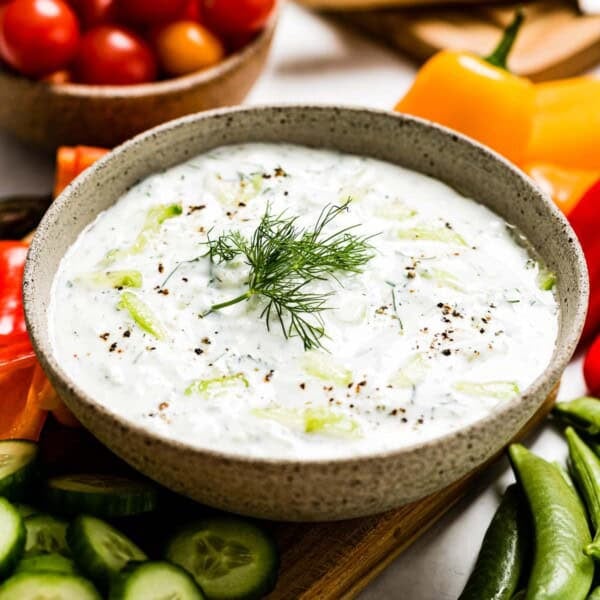

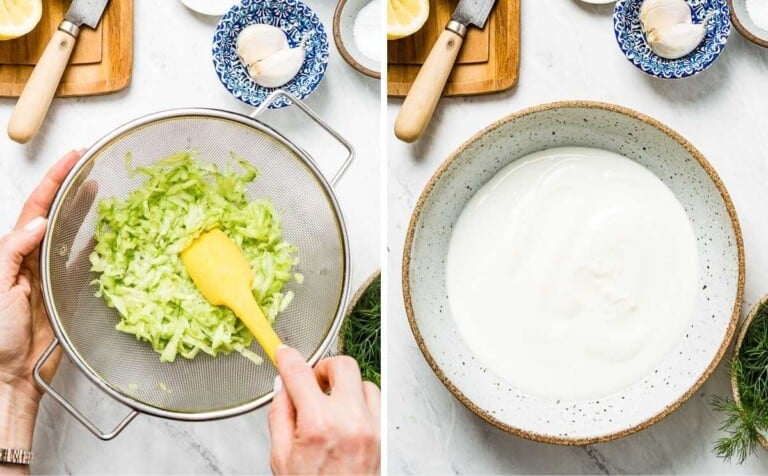

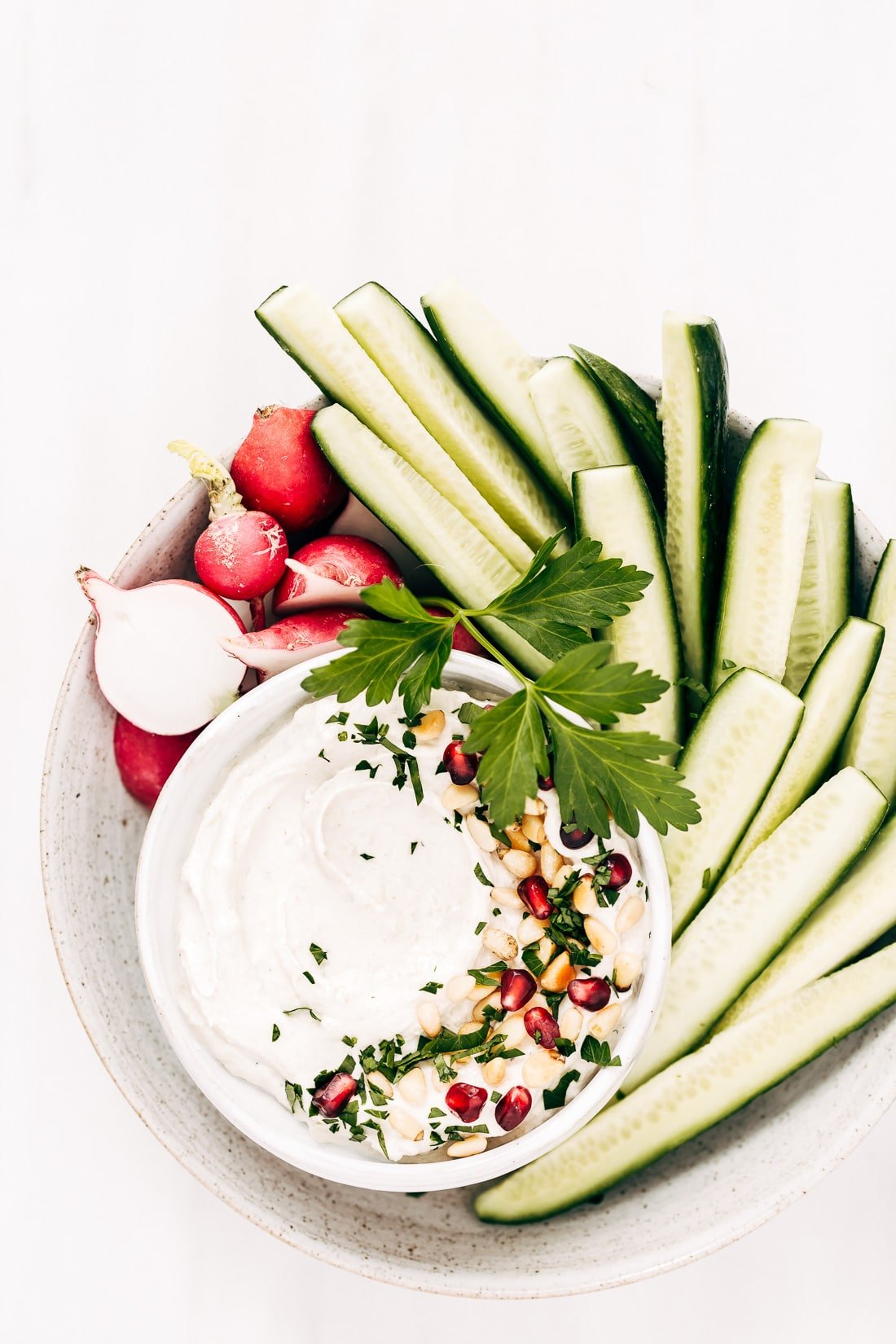


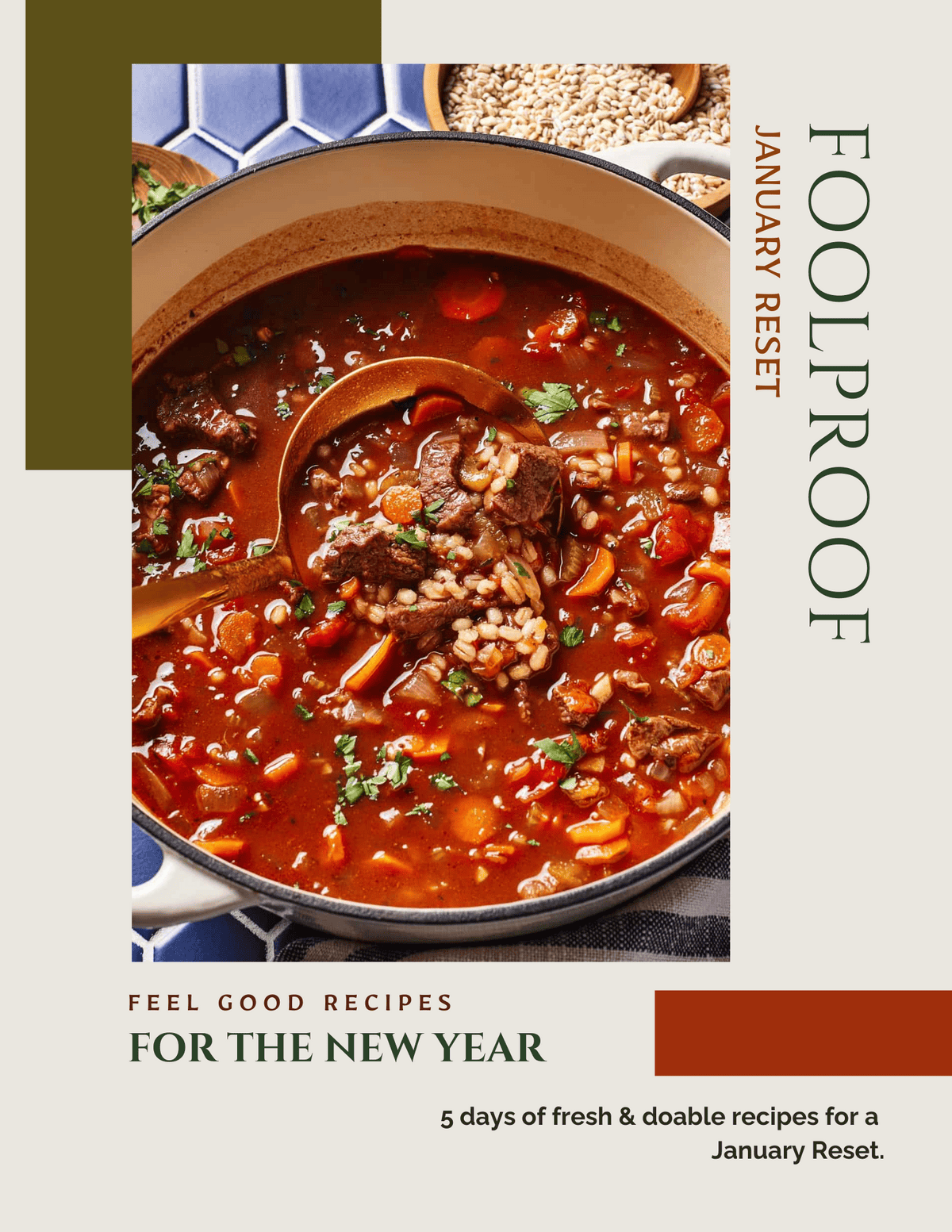









Selam,
bir Türk olarak CACIK a tsatsiki denmesi beni biraz üzer, çok milliyetçi değilim. gene de
Üstelik salatalik rendelenmez diye biliyorum.
80 yaşinda bir İstanbulluyum. Emekli olduktan sonra Bodrum da yaşıyoruz.
Hoping you don’t mind my objection.
Being quite new follower of your blog, I do enjoy yor recipes.
Sevgiler
Sermin Hanim merhaba,
Tariflerimi begenmenize cok sevindim.
Sizin tahmin edebileceginiz gibi bir cok yemegin birden fazla yapilis sekli olabilir. Ben cacigi salataligi rendeleyerek yapmayi seviyorum. Zira siz farkli sekilde yapmayi isterseniz tabiiki salataligi istediginiz sekilde kullanabilirsiniz.
Cacik ve tzatziki tabiiki ayni sey. Fakat benim blog imin okuyucu kitlesi daha cok Amerika, Kanada, ve Ingiltere oldugu icin, cacik kelimesi tzatziki kadar bilinmiyor. O nedenle tzatziki yi sectim.
Fakat sayfamda, bizim mutfagimiza ait bir sure tarif var. Umarim vaktiniz olur ve bakarsiniz.
Bodrum’a Atlanta’dan selamlar.
Aysegul
I have so very much loved this sauce and could never get to close. I am very pleased with this one! The English Cucumber is definitely the key! I also used a garlic press instead of mincing. Ill be making this dozens of times.
Thank you!!!!!!
YAY! That makes me so happy to hear JJ. Thanks for coming by and taking the time to leave a review.
I have been making your Tzatziki sauce recipe since you first published it. It is absolutely the best! Only once or twice has there been any leftover for the next day’s lunch. Generally I use dill in it, unless I’m out of it; then I make it with flat leaf parsley. Both versions are absolutely delicious. The only changes I make are to reduce the kosher salt to 1/2 teaspoon, and sometimes I use 2 1/2 tablespoons of lemon juice if that’s what a half lemon yields. I even use your recipe when I make Mediterranean foods from other sites or cookbooks. Your recipe is just perfect. Thanks!
This makes me SO happy to hear Annette. Thanks for taking the time to review it. I truly appreciate it.